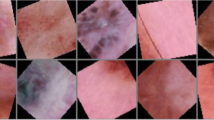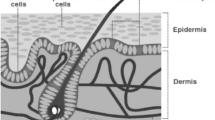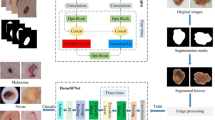Abstract
The latest computer vision and machine learning technologies have introduced various computer-aided diagnosis (CAD) systems to automate the early diagnosis of skin lesions. Nevertheless, improvements made by CAD systems are not optimal because of the similarity in the appearance of skin lesions of different classes as well as the limitations of segmentation. In addition, according to dermatologists, the shape of the lesion and its infiltration into the surrounding skin are decisive information for the diagnosis. Inspired by this idea, the proposed method is based on gradually expanding the lesion border by including the lesion-shaped border area in order to associate the input image with the corresponding skin cancer type using an end-to-end Inception-ResNet-v2 classifier. The main contribution of this work lies in investigating the Inception-ResNet-v2 model exclusively on the expanded lesion-shaped border. In fact, the obtained results showed that the proposed method is effective in achieving precision rates of \(95.6\%\) and \(97.26\%\) on HAM10000 and PH2 datasets, respectively.








Similar content being viewed by others
References
Balazs, H., Agnes, B., Andras, H.: Assisted deep learning framework for multi-class skin lesion classification considering a binary classification support. Biomed. Signal Process. Control 62, 102041 (2020)
Barhoumi, W., Khelifa, A.: Skin lesion image retrieval using transfer learning-based approach for query-driven distance recommendation. Comput. Biol. Med. 137, 104825 (2021)
Benedetti, P., Perri, D., Simonetti, M., Gervasi, O., Reali, G., Femminella, M.: Skin cancer classification using inception network and transfer learning. In: International Conference on Computational Science and Its Applications, Organization, pp. 536–545 (2020)
Burdick, J., Marques, O., Weinthal, J., Furht, B.: Rethinking skin lesion segmentation in a convolutional classifier. J. Digit. Imaging 31, 435–440 (2018)
Chen, J., Chen, J., Zhou, Z., Li, B., Yuille, A., Lu, Y.: MT-TransUNet: mediating multi-task tokens in transformers for skin lesion segmentation and classification. arXiv preprint arXiv:2112.01767 (2021)
Datta, S.K., Shaikh, M.A., Srihari, S.N., Gao, M.: Soft attention improves skin cancer classification performance. In: Interpretability of Machine Intelligence in Medical Image Computing, and Topological Data Analysis and Its Applications for Medical Data, pp. 13–23. Springer (2021)
Garg, R., Maheshwari, S., Shukla, A.: Decision support system for detection and classification of skin cancer using CNN. In: Innovations in Computational Intelligence and Computer Vision, pp. 578–586. Springer (2021)
Hosny, K.M., Kassem, M.A.: Refined residual deep convolutional network for skin lesion classification. J. Digit. Imaging 35, 258–280 (2022)
Hosny, K.M., Kassem, M.A., Foaud, M.M.: Skin cancer classification using deep learning and transfer learning. In: International Biomedical Engineering Conference, pp. 90–93 (2018)
Jayapriya, K., Jacob, I.J.: Hybrid fully convolutional networks-based skin lesion segmentation and melanoma detection using deep feature. Int. J. Imaging Syst. Technol. 30, 348–357 (2020)
Khan, M.A., Sharif, M., Akram, T., Damaševičius, R., Maskeliūnas, R.: Skin lesion segmentation and multiclass classification using deep learning features and improved moth flame optimization. Diagnostics 11, 811 (2021)
Kittler, H., Pehamberger, H., Wolff, K., Binder, M.: Diagnostic accuracy of dermoscopy. Lancet Oncol. 3, 159–165 (2002)
Linton, C.P.: Describing the shape of individual skin lesions. J. Dermatol. Nurses’ Assoc. 3, 230–231 (2011)
Mendonça, T., Ferreira, P.M., Marques, J.S., Marcal, A.R., Rozeira, J.: PH 2-A dermoscopic image database for research and benchmarking. In: Annual International Conference of the IEEE Engineering in Medicine and Biology Society, pp. 5437–5440 (2013)
Moldovanu, S., Damian Michis, F.A., Biswas, K.C., Culea-Florescu, A., Moraru, L.: Skin lesion classification based on surface fractal dimensions and statistical color cluster features using an ensemble of machine learning techniques. Cancers 13, 5256 (2021)
Nadipineni, H.: Method to classify skin lesions using dermoscopic images. arXiv preprint arXiv:2008.09418 (2020)
Park, C., Awadalla, A., Kohno, T., Patel, S.: Reliable and trustworthy machine learning for health using dataset shift detection. Adv. Neural. Inf. Process. Syst. 34, 3043–3056 (2021)
Sekhar, S.R.K., Ranga Babu, T., Prathibha, G., Vijay, K., Chiau Ming, L.: Dermoscopic image classification using CNN with handcrafted features. J. King Saud Univ. Sci. 33, 101550 (2021)
Tschandl, P., Rosendahl, C., Kittler, H.: The ham10000 dataset, a large collection of multi-source dermatoscopic images of common pigmented skin lesions. Sci. Data 5, 1–9 (2018)
Xie, Y., Zhang, J., Xia, Y., Shen, C.: A mutual bootstrapping model for automated skin lesion segmentation and classification. IEEE Trans. Med. Imaging 39, 2482–2493 (2020)
Yilmaz, E., Trocan, M.: Benign and malignant skin lesion classification comparison for three deep-learning architectures. In: Asian Conference on Intelligent Information and Database Systems, pp. 514–524. Springer (2020)
Author information
Authors and Affiliations
Corresponding author
Additional information
Publisher's Note
Springer Nature remains neutral with regard to jurisdictional claims in published maps and institutional affiliations.
Rights and permissions
Springer Nature or its licensor (e.g. a society or other partner) holds exclusive rights to this article under a publishing agreement with the author(s) or other rightsholder(s); author self-archiving of the accepted manuscript version of this article is solely governed by the terms of such publishing agreement and applicable law.
About this article
Cite this article
Dakhli, R., Barhoumi, W. A skin lesion classification method based on expanding the surrounding lesion-shaped border for an end-to-end Inception-ResNet-v2 classifier. SIViP 17, 3525–3533 (2023). https://doi.org/10.1007/s11760-023-02577-0
Received:
Revised:
Accepted:
Published:
Issue Date:
DOI: https://doi.org/10.1007/s11760-023-02577-0




